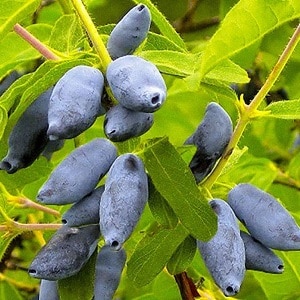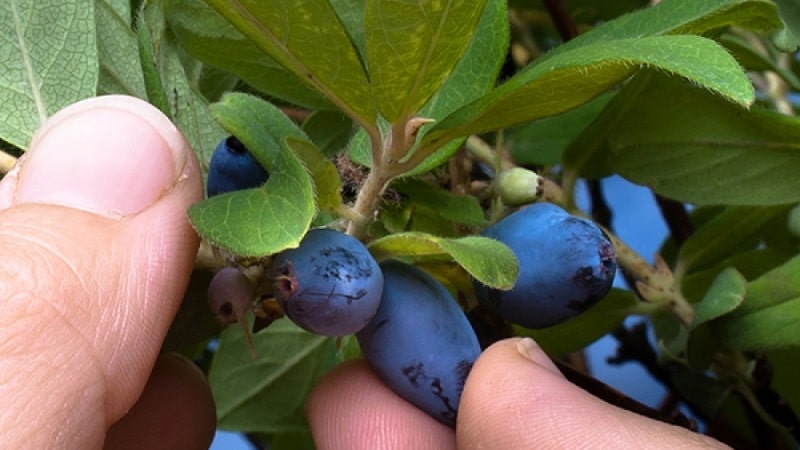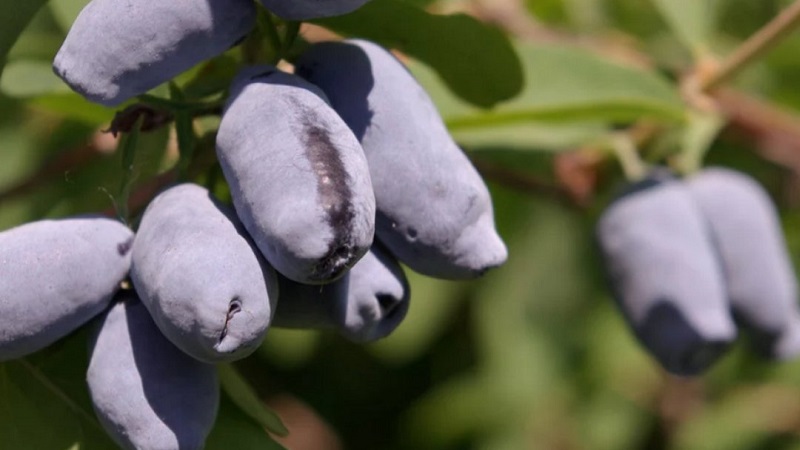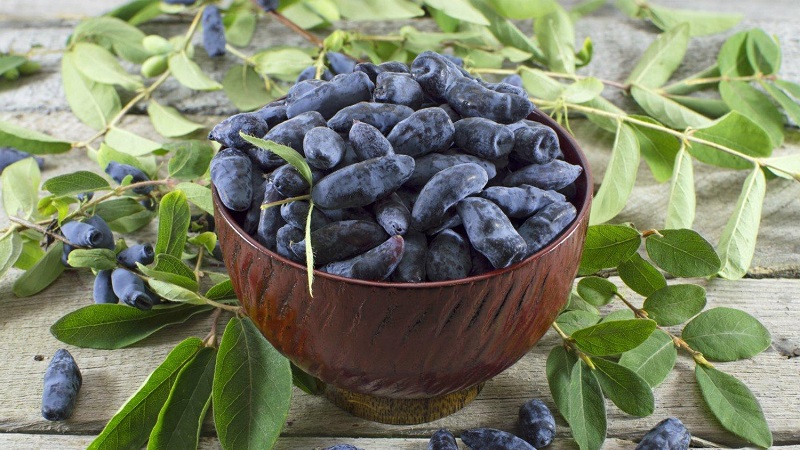High-yielding tasty variety of honeysuckle Slastena
Honeysuckle Slastena or Sweet Tooth is a relatively young variety, characterized by high frost resistance and productivity, and outstanding taste. The variety belongs to edible plants, but lacks large berries compared to the Bakchar giant, Leningrad giant, Delight and other large-fruited varieties. Despite this drawback, Slastena is in demand among beginners and experienced gardeners. Below are the main characteristics of such a plant and the rules for growing it.
Description of the honeysuckle variety Slastena
Sweet tooth is a high-yielding variety. The main feature is its berries.
They are truly recognized as the sweetest fruits. A detailed description of the bush is as follows.
Origin and development, history of breeding
The variety was developed by the originators of the Kamchatka Research Institute of Agriculture in 2004. The tests lasted about nine years. And after satisfactory cultivation results, Slastena was included in the State Register of Breeding Achievements in 2013.
Numerous tests have proven that the variety develops well in the northern regions and on the lands of the CIS countries.
Characteristics, description of appearance, taste
Honeysuckle Slasten has:
 A compact, low-growing bush with strong thickened shoots. The upper part of the branches is painted in a crimson hue, gradually flowing into crimson towards the trunk. The height of the bush does not exceed 1 m.
A compact, low-growing bush with strong thickened shoots. The upper part of the branches is painted in a crimson hue, gradually flowing into crimson towards the trunk. The height of the bush does not exceed 1 m.- The leaves are rich green, slightly pubescent. They thickly cover the bush.
- The berries are cylindrical in shape, with a dense peel, and a short brownish-green stalk. The color of the fruit is bluish with a waxy coating. The berries are sweet, pleasant without sourness. The average weight is 1.15 g.
Reference. Honeysuckle grows for more than fifty years and at the same time maintains its productivity throughout the entire growth period. Fruiting begins the next year or two years after planting.
Features of the use of this variety
Sweet tooth is an edible variety. The berries are well suited for making jams, preserves, and compotes. They are added to baked goods or eaten fresh. Tasters rated the sweetness of the fruit 5 points out of 5 possible.
Productivity and fruiting
The fruiting period is from June 1 to June 20.
One bush produces up to 4 kg of berries.
Ripening period
Honeysuckle has early ripening time, if grown in the southern regions, and medium - in cold regions.
Resistance to diseases and pests
There is no exact information on the resistance of honeysuckle to diseases and pests. With poor care, it is affected by aphids, mites, scale insects, leaf-eating pests, blight, cercospora blight, ramularia, and powdery mildew.
Resistance to cold and drought
The variety can withstand frosts down to -45°C and short-term drought. Honeysuckle prefers abundant watering, since it is a moisture-loving crop.
For which regions is it best suited and what are the climate requirements?
Sweetweed is not demanding on the climate, so it is suitable for growing in Siberia, the Urals, the Moscow region, the middle zone, the Leningrad region, and the North-Western region.
In cold areas it requires shelter for the winter.
The main advantages and disadvantages of the variety
This honeysuckle quickly gained popularity due to the following advantages:
- high taste qualities - the fruits are sweet, pleasant, without sourness or bitterness;
- compact size - the bush is easy to form, since its height and width do not exceed one meter;
- frost resistance - flowers can withstand frosts down to -8°C, plants - up to -45°C;
- high yield - with proper cultivation, one bush produces up to 4 kg of fruit;
- unpretentiousness - planting honeysuckle is available in any region, without restrictions.
Disadvantages include the requirement for moisture and the modest size of the fruit. Despite these small disadvantages, gardeners continue to grow Sweet Tooth with pleasure.

What is the difference from other varieties and hybrids
The main difference is that Slastena requires pollinators, but at the same time it is considered a good pollinator for other varieties.
Experienced gardeners recommend planting Amphora, Nymph and Violet at a distance of 1-1.5 m.
Agricultural technology
Honeysuckle requires proper planting and further care. The following tips and tricks will help beginners avoid making mistakes.
Choosing a place in the garden and preparing holes
She has a sweet tooth, although she is known for her unpretentiousness, prefers areas with plenty of sunlight, but also grows well in partial shade.
Three days before planting, dig a hole measuring 40x40x40 cm. Mix 10 kg of humus, 300 g of ash, 100 g of double superphosphate and 30 g of potassium sulfate. This mixture is added to the pit.
Important! Pits are prepared only in soil with a moisture content of at least 80%. In this case, soil temperatures are allowed within the range from +15 to +25°C (depending on the planting region).
Preparing for landing
For landing choose a healthy seedling in specialized nurseries.High-quality planting material has the following characteristics:
- age two years;
- the presence of three stems with a height of about 40 cm, but not higher than 150 cm;
- there are even and intact branches with healthy green buds;
- there is a well-developed root system without signs of rot.
The seedling is placed in a container with soil or sand if the time for planting has not yet come.
Soil requirement
They are as follows:
- location of groundwater no higher than 1.5 meters to ground level;
- loamy, soddy-podzolic or chernozem;
- neutral acidity (within 5.5-6.5 pH).
Dates, scheme and rules of planting
The optimal time for planting honeysuckle is September. If the seedling has a closed root system, work is carried out from late April to early May.
When creating planting holes, maintain an interval of about 3 m between rows, and 1-1.5 m between holes. At the same time, prepare holes for pollinators. It’s good when two or three different varieties are planted nearby.

Then adhere to the following landing algorithm:
- Place the seedling in the center of the hole.
- Gently straighten the roots.
- Fill the soil into the hole, deepening the neck by 5 cm.
- Water the plant generously with warm water at a temperature of +20°C. Pour 5-7 liters under each bush.
- Mulch the tree trunk circle with fallen leaves, humus, sawdust or pine needles.
Features of cultivation
Honeysuckle does not require complex care. It is watered, the trunk circle is kept clean, and trimmed. For the winter they are covered with spruce branches and special material.
Nuances of care
To obtain a healthy bush and a rich harvest, perform the following activities:
- Watering. The variety loves moisture, so the plant is watered every other day. One bush consumes 5 liters of water.The procedure is carried out from late April to early October. Sprinkle early in the morning or in the evening. Otherwise, the foliage will burn from the sun.
- Weeding and loosening. Removing weeds will get rid of pests and infections. Loosening is necessary to allow air to enter the root system.
- Feeding. For the first two years, honeysuckle is not fertilized. From the third year, when the snow melts, 500 ml of urea solution is added under the bush (1 tablespoon dissolved in 10 liters of water). At the end of April, 10 liters of humus are placed under the bush. During the flowering and fruiting period, 600 ml of ash solution is added to each plant (1 glass is dissolved in 10 liters of water). After harvesting, pour 10 liters of slurry under one honeysuckle. In autumn, fertilize with double superphosphate and potassium salt (15 g per plant).
- Trimming. In early April or mid-October, diseased, dry branches are removed, forming a neat crown.
Attention! Care includes disease and pest control. Shrubs are carefully inspected for signs of damage.
Pollinators
Good pollinators - Violet, Amphora And Nyfma. Their flowering periods coincide, so high-quality pollination occurs.

Disease and pest control
The sweet tooth is eaten by aphids, mites, scale insects, leaf rollers, sawfly caterpillars, and moths. Their presence is detected by damaged, twisted leaf plates and small specks and holes.
The fight is carried out with the help of Aktara, Konfidor, Aktellik, Inta-Vir. Solutions are prepared strictly according to the instructions.
With increased air humidity and dampness, honeysuckle is attacked by spotting, cercospora blight, ramularia blight and powdery mildew. In this case, the leaves fall off, the branches become covered with tubercles and signs of rotting are observed.For treatment, Fundazol, Topaz, colloidal sulfur, copper-soap solution and wood ash are used.
Important! Chemicals are not used during the period of berry set and fruiting. Prepare a thick soap or ash solution. Spray the bushes late in the evening once every two weeks.
Preparing for winter
In mid-October, before the first snow, unnecessary branches (weak, dry and deformed) are removed from the honeysuckle. Water again with warm water. The trunk circle is covered with spruce branches or insulated fiber. The bush is covered with mesh, agrofibre or nylon. The measures will protect the berry garden from rodents.
Reproduction
An effective method of reproduction is cuttings green woody shoots. They are prepared during the formation of green fruits. When cutting the stem, make sure that two pairs of leaves and one internode remain on it.
They are then wrapped in burlap and immersed in a box of wet sand. Water systematically so that the humidity remains within 85%. In spring, planting is carried out according to the same principle as for biennial plants.
Harvesting
Timely picking of berries eliminates the loss of the main part of the harvest. A slight delay will result in the fruits being eaten by birds or rotting on the ground.

How and when to collect
Honeysuckle being collected as the fruits ripen. Ripe berries become soft and acquire a characteristic shade. They are carefully removed so that the rest do not fall to the ground.
Store honeysuckle in the refrigerator, in the vegetable compartment, but no more than three days. It is frozen and used to prepare various sweet dishes.
What difficulties may there be when growing
There are no problems when growing this variety.It is enough to follow the basic rules of agricultural technology for the bushes to grow and produce an annual harvest.
Tips and reviews from experienced gardeners about the variety
Experienced gardeners recommend:
- take good care of the plantings, performing all care activities;
- do not forget to inspect the bushes for the presence of pests and fungi;
- use at least three or four different pollinators during planting;
- take into account the planting scheme and timing;
- monitor the cleanliness of the tree trunk circle.
Reviews about Sweet Tooth are only positive. Here's what gardeners from different regions think about it:
Natalya, Kurgan: “Slastena has been growing on my plot for more than five years. Always produces a stable harvest. It’s easy to care for, so you don’t have to spend a lot of time in the berry garden. Every year, 3 kg of berries are harvested from one bush, sometimes more.”
Svetlana, Kazan: “Our family loves honeysuckle, so I have a separate area with such plants. I grow various varieties, including Slastena. Its berries are not so large, but the sweetest of all. We use them only fresh. And growing this variety is a pleasure.".
Conclusion
Honeysuckle Slastena is an unpretentious variety, but requires some care. The main thing is to follow the rules for planting and further care. Water, fertilize, remove grass and loosen in a timely manner. This is necessary to obtain a good harvest and prevent the appearance of parasites and fungus.